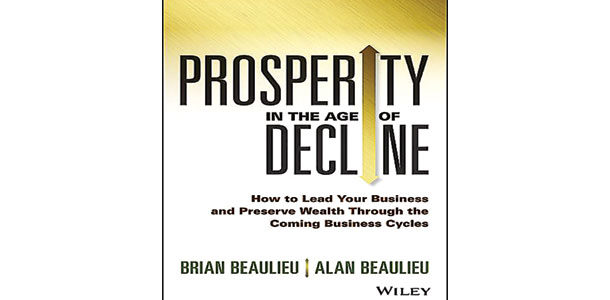When, not if. That’s the word respected economists use to talk about the next global economic crisis. And the coming downturn will last 10 years. That should catch your attention, no matter what your age.
This magazine issue is devoted to “the state of the dairy industry.” Let’s elevate 10,000 feet above that because the challenges we will face are much bigger than the dairy sector.
Prepper or prepared?
The “when-not-if” economists I follow are Brian and Alan Beaulieu from ITR Economics. They recently published a book titled, Prosperity in the Age of Decline: How to Lead Your Business and Preserve Wealth Through the Coming Business Cycles.
The title may prompt you to think, “Here is another one of those doom-and-gloom soothsayers who wants us all to buy gold or store guns and food in our fall-out shelters.”
I’m not a prepper. I do, however, believe in being prepared for anything. I look at numbers and trends, especially when they contradict what the media and other supposed gurus preach as they feed the 24-7 news cycle. What is “common knowledge” in the news today may not be true when clear-headed people examine what is really happening.
Let’s look at the overall economic cycles ITR sees ahead and the drivers behind these cycles. Then I’ll review the book’s suggestions for how to prepare for and manage through the likely cycles.
Between now and 2030
The good news is that the Beaulieu brothers believe 2015 and 2016 will be good years of solid economic growth. In general, the next 15 years are going to be good. Yes, there will be ups and downs and strengths and weaknesses in various sectors. In general, consumer activity, medical sector activity and government spending will provide the base for economic stability.
The authors urge business leaders to aggressively take advantage of this rising trend. Use this time to invest in wealth-creating assets, improved efficiencies and competitive advantage. “And enjoy the rise,” they say.
Beginning in 2018-2019, the authors see inflation starting to enter the picture. If you must borrow to invest, do it early on and at fixed rates because interest rates will increase, and you will not want to carry debt or own depreciating assets once the decade of 2030 to 2040 arrives.
The Great Depression of the 2030s
The economic growth and inflationary spiral up in the economy is going to peak and hit a wall around 2030, according to the authors. They predict a prolonged depression beginning in the 2030s due to the convergence of a few significant trends that are difficult to stop.
Demographics
There is one “dominant trend” driving the U.S. to financial insolvency: The aging of the population along with the entitlement programs tied to aging. People older than 65 are the fastest-growing segment of the U.S. population, and it is simply not viable for the productive citizens to fund the needs of the elderly. It is highly unlikely that there will be a political solution to this problem.
The authors point out that the real problem is the lack of balance between people older than 40 compared with those 30 and younger. Great civilizations throughout history have always had more young people than older people. Young people pay the taxes that support the country.
Fortunately, the U.S. is actually in a better position demographically than its trading counterparts, and this should help the U.S. and the dairy industry remain competitive globally.
Countries with large percentages of aging people are Japan (32.2 percent), Germany (27.9 percent, also true for Europe as a whole) and Canada (24.8 percent). Considerably less gray populations are India (8.9 percent), Brazil (12.2 percent), Mexico (11.5 percent) and Central America excluding Mexico (11.1 percent).
One game-changer for the U.S. with regard to this “people balance” is immigration. It can offset the declining birth rates as long as the immigrants are not dependent citizens. The dairy industry has considerable value to offer as we engage in public policy discussions regarding our skilled workforce, many of whom are Hispanic.
Inflation
We have lived in such a prolonged period of low inflation that many do not remember what it can do. Extreme inflation does not need to occur for the U.S. to have a significant problem. Once inflation takes hold, it spirals to feed itself. The authors see inflation kicking in in the years 2018-2019 and warn us to watch for it.
Inflation drivers are:
- Growth of the money supply
- Health care inflation driven by increased demand
- Environmental imperatives: “Going green” without considering who bears the costs
- Increasing labor prices: Not because there are too few employees, rather there are too few skilled employees
Inflation’s effects will contribute to the prolonged nature of this depression: Savings reduced, lower standard of living, higher unemployment. A downward spiral begins that will take many years to break.
Sovereign debt
The U.S. has and continues to build an enormous debt that will be a significant factor by the 2030s. The result will either be higher taxes or increases in borrowing, and neither is a good solution. Expect a decrease in the value of the U.S. dollar if the government chooses to print more money, and expect a real fight for any government spending other than the entitlement programs for our aging population.
The pain of the U.S.’s woes will spread around the world, just as it did in 2008 and 2009. The authors note that Australia fares the best of all countries, as it is less dependent on exports to the U.S. than many others. Australia also has less debt and favorable demographics compared to the U.S.
Managing through
Understanding these trends and anticipating how you are going to interact with them is key to planning the future of your business. While the U.S. economy is huge as a whole, it is still possible for businesses and individuals to outmaneuver the effects of these trends.
- Save and invest now. Saving and cutting costs now will not do the trick. You must invest – because $1 in 2015 will buy a lot more than $1 in 2030.
- Focus business interests on countries with comparatively young populations. China and Russia may make sense today; however, look for countries where there is an expanding middle class, not a shrinking one. These include India, Mexico, the rest of Central America and Australia. These countries will also hit the wall in 2030 but have a better chance of a softer landing.
- Reduce and eliminate debt as we approach 2030. Be in the strongest financial position possible to withstand a slowdown that is not typical and could last up to a decade. If you are careful, you can even be in a position to buy distressed assets and put people to work as you keep them going.
- Secure talent. Recognize that the demographic trends mean a tightening labor market, and it will be hard to find and retain talented team members.
- Equip your kids. One thing that bothers me about a decade-long depression is the effect it will have on Generation Z, who will be just coming out of college and in their prime earning years. PD

Scott Stewart
CEO
Stewart-Peterson Inc.







